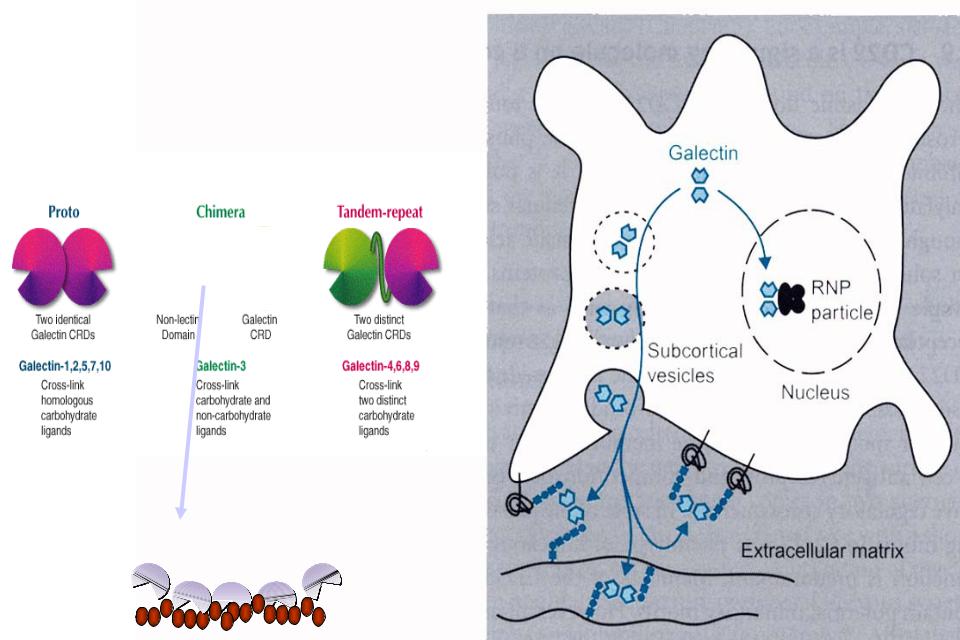
- •Лекция 5
- •РОЛЛИНГ
- •Е- и Р-селектин опосредованный РОЛЛИНГ
- •L-селектин опосредованный РОЛЛИНГ
- •селектины и их рецепторы
- •углеводы - лиганды селектинов
- •комплекс Е-селектина с SiaLex
- •Другие лектины млекопитающих:
- •ASGPR. Как открыли первый лектин млекопитающих
- •трехсубъединичный ASGPR
- •Требования к точной структуре гликана
- •маннозный рецептор
- •маннозный рецептор (MR) макрофагов,
- •коллектины и родственные белки (не- мембранные!), сходство с белками системы комплемента
- •лиганды коллектинов
- •Связывание коллектина с бактерией и отсутствие оного в случае N-цепей на клетке
- •сиглеки
- •На каких клетках?
- •Углеводная специфичность
- •сиглек-2 на В-лимфоцитах.
- •сиглек-2
- •что узнает сиглек-1
- •Known and putative functions of Siglecs
- •биологические роли
- •галектины
- •галектин-3
- •комплекс галектина-1 с Gal 1-
- •бактериальные токсины
- •холерный токсин
- •цитокины связываются с углеводами
- •лектины как инструменты исследования
- •другие углевод- связывающие и модифицирующие белки:
- •ГСЛ-деградирующие ферменты
- •ГП-деградирующие
- •Гликозидазы и гликозидозы
- •Лекция 5
- •гомология С-лектинов
- •биологическая роль галектинов …

сиглек-2 на В-лимфоцитах.
цис

сиглек-2
Хоминг в костный мозг
Механизм «включения» толерантности к собственным антигенам

что узнает сиглек-1
Known and putative functions of Siglecs
With the exception of MAG and CD22, wherein biological roles in glial cells (maintenance of myelin organization and inhibition of neurite outgrowth) and B cells (dampening the response to BCR ligation), respectively, are well documented, we do not yet know the physiological functions of any other Siglec. The fact that Sn and CD33rSiglecs are found predominantly on cells of the innate immune system suggest that this is where their primary functions lie. Given the highly conserved preference of Sn for α2-3-linked Neu5Ac and to a lesser extent for α2-8-linked Neu5Ac, its presence on tissue macrophages, and the lack of cytosolic signaling motifs, it is reasonable to speculate that Sn’s primary role may actually lie in recognition and phagocytosis of bacterial pathogens that express Sias. In keeping with this, α2-3-and α2-8-linked Neu5Ac (and not Neu5Gc) are the dominant sialylated motifs on bacterial pathogens studied to date. Of course, one cannot rule out an additional intrinsic role of Sn in interactions with other cell types within the hematopoietic or lymphoid systems. The CD33rSiglecs stand in striking contrast to Sn, having rapidly evolving Sia-binding preferences and expression patterns, and inhibitory cytosolic motifs. The best explanation for the findings to date is that these molecules serve to detect the host “sialome” as “self,” thereby down-regulating innate immune cell reactivity via their ITIM motifs. In keeping with this notion, a very recent study using siRNA and other techniques has demonstrated a “constitutive repressor activity” of CD33 on human monocytes that involves phosphoinositide 3-kinase–mediated intracellular signaling and requires Sia recognition to function optimally. However, it was also reported that one CD33-related Siglec could be involved in bacterial uptake.
In further exploring Siglec functions, we must remember that potential ligands could be formed not only by Sias on the same cell surface (or on the Siglec itself), but also on other cell surfaces or on soluble glycoproteins. Direct cell–cell interactions could thus potentially occur among Siglec-positive cells or between Siglec-positive cells and another other cell type. Soluble sialylated glycoprotein ligands could also interact directly with Siglec-positive cells, bridge between two such cells, or serve to inhibit cell–cell interactions involving Siglecs.

биологические роли
галектинов

галектины
T























TTTTT

галектин-3

комплекс галектина-1 с Gal 1-
больше, чемGal 1-4GlcNAc
4GlcNAc
(Gal, GalNAc, FucSia, Su)-Gal 1-4GlcNAc-X-X-X

бактериальные токсины
Clostridium tetani (tetanus toxin) |
GD1b, GT1b |
|
|
Clostridium botulinum (neurotoxin, type A-F) |
GQ1b, GT1b, GD1a |
|
|
Clostridium perfringens ( toxin) |
GM2 |
|
|
Clostridium perfringens ( toxin) |
Neu5Ac |
|
|
Vibrio cholera (cholera toxin) |
GM1 |
|
|
Vibrio mimicus (hemolysin) , |
GD1a, GT1b |
|
|
Vibrio parahemolyticus (thermostable direct |
GT1 |
hemolysin) |
|
|
|
E. coli (heat-labile enterotoxin) |
GM1 |
|
|
E. coli (heat-stable enterotoxin b) |
sulfatide |
|
|
Bordetella pertussis (pertussis toxin) |
GD1a; Neu5Ac 2-6Gal l-4GlcNAc |
Staphylococcus aureus (a toxin) |
Neu5AcGalGlcNAcGalGlc |
|
|
Staphylococcus aureus (y hemolysin, leucocidin) |
GM1 |
|
|

